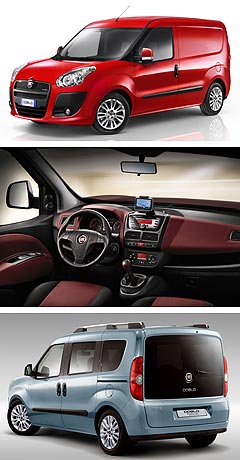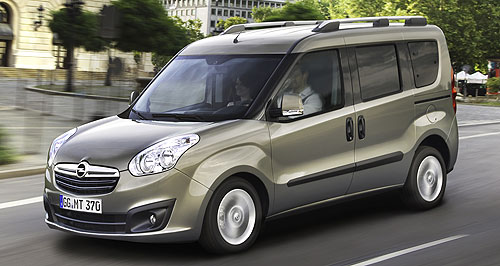Future models - Holden - ComboFirst look: Opel outs next ComboSmall mover: The Australian future of GM's next-gen Combo van is uncertain, with neither Holden or the forthcoming local Opel arm confirmed as takers. Next-generation Combo emerges in Europe but is no certainty for Australia18 Jul 2011 OPEL has unveiled its first all-new Combo in a decade, but the Australian future of GM’s next-generation small van remains uncertain. To be produced in both passenger car and commercial panel van configurations with two wheelbases and two roof heights, the redesigned Combo will be available in Europe from late 2011 with six diesel, petrol and compressed natural gas (CNG) engine options. The next Combo, which Opel claims will offer best-in-class cargo capacity of up to 4600 litres and a maximum one-tonne payload, will also be offered with the choice of two, five and seven seats. To be produced in Turkey alongside the Fiat Doblo on which it is based, it replaces Holden’s existing XC Combo, which first appeared in Europe in 2001 and was released in Australia in September 2002. However, Holden remains non-committal about the new model’s release in Australia, where Combo sales have been steady decline since a high of 1204 sales in 2004. “Basically, there’s nothing to report right now regarding Combo,” said Holden spokesman Jonathan Rose. “At this point in time, we’re still looking into the program.” Opel has sold up to 72,000 Combo vehicles annually in Europe since 1985, but so far this year Holden has sold just over 200 Combos – 32.9 per cent fewer than the same period last year, when Combo sales were 25 per cent down - for a 1.9 per cent share of the local van segment.  Left: The Fiat Doblo forms the basis of the Combo and is produced in the same Turkish factory. Left: The Fiat Doblo forms the basis of the Combo and is produced in the same Turkish factory.While the Australian van landscape is dominated by large commercials like Hyundai’s iLoad (30.7 per cent) and Toyota’s HiAce (27.1 per cent), the Combo is now also outsold by VW’s Caddy, which holds a 9.2 per cent share of the segment, with other compact rivals like Renault’s Kangoo, Citroen’s Berlingo and even Suzuki’s APV not far behind. If the new Combo does make it to Australia, where Holden will relaunch the Opel brand in 2012, GM may choose to badge it as an Opel and charge a higher price. Alternatively, continuing the model as a Holden is likely to generate more sales at the expense of profit margins, but without cheapening the Opel model range that will be aimed directly at Volkswagen with the likes of the Corsa, Astra and Insignia. Currently, the 1.4-litre petrol-engined Combo is priced from $21,280 plus on-road costs – less than the VW Caddy (from $21,990), Citroen Berlingo (from $22,990) and Renault Kangoo (from $24,490), but more than Suzuki’s APV (from $18,990). Opel says the new Combo panel van will be available with two wheelbases – 2755mm or 3105mm – resulting in overall vehicle lengths of 4.39 or 4.74 meters respectively, as well as two roof heights - 1.85 or 2.10 metres. It will also be offered as a “versatile car-van” with the option of five or seven seats with or without side windows. While the Combo people-mover will come standard with two sliding side doors and a top-hinged rear tailgate, van variants will be available with one or two sliding side doors and fitted with rear barn doors. Both the short- and long-wheelbase Combo vans are claimed to offer best-in-class cargo space of 3800 and 4600 litres respectively, as well as class-leading cargo length, height and distance between wheel-arches. Four turbo-diesel engines will be available in Europe, including 1.3 CDTI and 1.6 CDTI oil-burners both offering 66kW, plus 77kW 1.6 CDTI and 99kW 2.0 CDTi engines. The new Combo’s 1.4-litre petrol four offers 70kW (up from the current model’s 66kW), while the CNG version delivers 88kW. The 1.4 petrol and 1.3 CDTI engines will come standard with a five-speed manual transmission, while the CNG engine and the more powerful CDTI units score a six-speed manual and the 66kW 1.6 CDTI will be available with Opel’s ‘Easytronic’ automated five-speed manual transmission. A fuel-saving idle-stop function that switches off the engine while the vehicle is stationary will be optional in Europe in CNG and Easytronic models, while also reducing the cost of ownership will be a longer 35,000km service interval for all diesel models. In Europe, all new-generation Combo models will come standard with a driver’s airbag, ABS brakes, central locking, power steering, a height- and reach-adjustable steering column, electric windows, a four-way adjustable driver’s seat and a tyre repair kit. In addition, the passenger version will be offered there in three specification grades - Essentia, Enjoy and Cosmo – will comprise front side airbags, rear power windows and remote central locking.  Read more18th of July 2011  VW lacks restraint, says GMGM accuses VW chief of “fanning speculation” of Opel sale on eve of Ampera launch27th of April 2011  First look: Opel maxes out Astra GTC coupeProduction GTC coupe emerges and could top Opel’s Astra line-up in Australia |
Click to shareHolden modelsResearch Holden Motor industry news |










Facebook Twitter Instagram